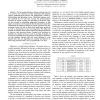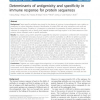650 search results - page 21 / 130 » Analysis and design of sequencing rules for car sequencing |
ICDE
2010
IEEE
15 years 4 months ago
2010
IEEE
— The increasing infectious disease outbreaks has led to a need for new research to better understand the disease’s origins, epidemiological features and pathogenicity caused b...
CIKM
2005
Springer
15 years 3 months ago
2005
Springer
We study suitable indexing techniques to support efficient exact match search in large biological sequence databases. We propose a suffix tree (ST) representation, called STA-DF, ...
BMCBI
2011
14 years 1 months ago
2011
Background: Target specific antibodies are pivotal for the design of vaccines, immunodiagnostic tests, studies on proteomics for cancer biomarker discovery, identification of prot...
BMCBI
2002
14 years 9 months ago
2002
Background: Expressed sequence tags (ESTs) are single pass reads from randomly selected cDNA clones. They provide a highly cost-effective method to access and identify expressed g...
CIKM
2009
Springer
15 years 1 months ago
2009
Springer
A suffix tree is a fundamental data structure for string searching algorithms. Unfortunately, when it comes to the use of suffix trees in real-life applications, the current metho...



